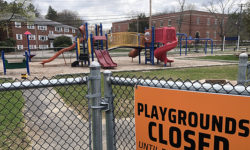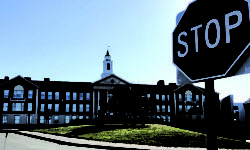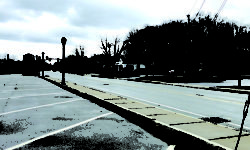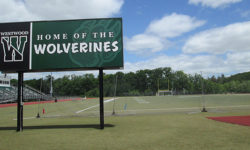By Stephen Press
Hometown Weekly Editor
Wednesday, March 25.
The mission is simple: drive through all of Hometown Weekly’s communities, maintain appropriate distance from passers-by, and record what’s changed since the coronavirus pandemic began. I’ve plotted a sensible route: I’ll head from Walpole center up Route 27, through Medfield and into Sherborn. From there, I’ll jump on 16 and head towards Wellesley, pick up 135 from there into Needham center, and then roll down Chestnut and Dedham Street into the heart of Dover. Finally, from there, I’ll head down Walpole Street towards 109, follow it into Westwood, double back to Nahatan Street, and jump on 1A back to Walpole center. I’ll stop a few times on the way, too, for photos and groceries.
My Walpole center start immediately presents a recurring theme: an absence of traffic. It feels like I’m driving at 7 a.m. on a Sunday morning. Taking a left from Main Street on to Elm Street at 9:45, there is no line at the light, and no traffic in the opposite direction to impede my turn. There are no other cars at the four-way stop. There is no pedestrian traffic around the commuter rail station, which is completely empty. Even an officer directing traffic alongside a public works project seems at a loss; he waves me on, despite there being no other cars in sight.
As I make my way into Medfield, I steel myself for the usual routine. Typically, I wait for a few light cycles at the intersection of 27 and 109. In addition to the line of cars waiting for me, there’s usually also a pedestrian or two waiting to cross the street.
In truth, I’ve grown to appreciate these stops at local traffic lights, as it gives me an excuse to look around and take in my surroundings. Today, though, even the intersection seems to be in on the social distancing fad. No pedestrians. A small handful of cars. The light stops me, ever so briefly, before quickly turning green and moving me on my way.
I stop in a nearby parking lot to take a few photos and assess the landscape. It looks the way one would expect it to during a hurricane, minus the inclement weather. The sidewalks and parking spaces are empty. There is a silence in the center of town that I’ve only experienced at the darkest hours of night; to encounter it now is wholly bizarre.
On to Sherborn, where my ride is little different. Few cars pass on the way there. When I head down Sanger Street, I find the Town Hall lot, typically bustling with cars and individuals, completely quiet. I count four vehicles, not including a police SUV by the entrance. Rolling down North Main Street, I am struck by how empty everything seems.
Sherborn, it should be stated, is wonderfully placid on a normal day. One does not head to its center to feel like they’re in Times Square, but rather to breathe in an idyllic slice of New England small town life. Today, though, as I cruise by the fire department, it evokes a ghost town. I marvel to myself that this is the same spot where, just months ago, I kept my eyes peeled for ice-cream-cone-wielding families walking the road. There are no such sights today.
By the time I’m in Wellesley, I’m a bit better prepared for what awaits me, but no less surprised. I have my pick of spaces on Church Street, long my preferred parking spot for any business on busy Central Street. Today, though, it wouldn’t have mattered; I find Central itself empty of cars. A gentleman and I, the only pedestrians in sight, exchange “good morning” greetings there, maintaining ample, conspicuous social distance as we do so. The look we exchange from afar seems to say far more than our actual interaction; to my eyes, it seems a sort of knowing acknowledgement of the surreality of this particular moment. This brief interaction will be a highlight of my journey, and arguably the most intimate human contact I will experience.
On to Needham, where I’ve learned my lesson. I anticipate finding an excellent parking space on Great Plain Ave, and I do with no problem. My car slows to a halt on the corner of Chestnut Street. A surgical-mask-wearing man walks down the street and towards me as I park, ducking into his truck before I can ask for a name or photograph. I cross the street with ease - the first time I can recall doing so outside of the early morning - and head to the town common. How many times have I been here during times of celebration, when finding a few feet of personal space can seem like a challenge? Empty of pedestrians, it feels so much smaller. Every time I’ve been here in the past, finding photo subjects has been easy - just look for a smiling child, a happy couple, or a few neighbors in discussion. Without the luxury of such photogenic fodder, I am forced to shoot empty landscapes of the common.
Back in the car for a pit stop at the grocery store. In the supermarket aisles, neighbors keep their distance, approaching shelves as though they were paintings at a museum: if somebody’s there in front of them, best to let them have their space, their moment, before moving in themselves. I stop to pick up two serrano peppers and a tomato - both of which I find easily - and notice that despite the last weeks of hoarding behavior, the essentials are all there. This will be a reassuring theme of the day: it seems that while civilian traffic has dwindled to an appropriate halt, commercial traffic, from this reporter’s perspective, has remained the same as usual - and it is reflected on these store shelves.
On my way to Dover, I begin noticing something else on the road: people are driving more courteously than usual on these rural thoroughfares. Despite the complete lack of traffic, drivers are stopping to let others make turns; they’re letting neighbors go first at intersections and four-way stops. The hallmark aggression of the stereotypical New England driver is entirely absent today. Perhaps, starved of close contact with others outside our families, we’ve taken to expressing our neighborly impulses through vehicular altruism.
Upon arriving in the center of Dover, I find it it’s much the same as my other destinations. Whereas my Needham jaunt made the town feel much smaller, though, the Dover stop highlights the expansiveness of the green. My fondest memories of this place are from Dover Days, when the community comes out in force to celebrate. Today, though, the green strikes me as an empty pasture. The steady flow of traffic that would accompany this hour on a normal day is nowhere to be found. I climb the back steps of Town Hall for a photo, and to reflect before heading to Westwood.
A couple months back, I’d stopped at the Westwood Public Library to meet with a friend, right around this time of day. Back then, the parking lot was filled to the brim, the traffic on High Street significant enough to delay my arrival by a couple minutes. Now? One could conduct a garden party in the lot, were it not for the ever-present specter of COVID-19 infection. The traffic and perpetual buzz around the town’s municipal buildings, realtors and eateries has ceased.
Just down the road at the high school, it’s just as deserted. A line of buses sits in the lot, waiting to be called back into action. The playing fields are empty. Printed white signs on the doors of Westwood Recreation, indicating closure until further notice, speak volumes. It is a depressing note on which to end my grand tour.
My final stop of the day brings me full-circle to the parking lot of a Walpole eatery, from which I take a few photos of the forlorn town center. About a week ago (it feels far longer than that, but it is actually a week), a friend and I met for a lighthearted lunch at this same eatery to trade stories and observations.
The lot is empty now. The center of town is eerily quiet for noon on a Wednesday.
I make my way back to the car to attempt digesting the last few hours from a “bigger picture” perspective, but all I can think of is that lunch with my friend a week back. Maybe there’s something to that.
For years, I’ve been covering these communities. For years, I’ve been asking the same thing of folks: “What makes this place special?”
The answer inevitably comes back the same every time: “The people.” Honestly, I’ve heard the reply so often that I’d started cynically rolling my eyes before even asking the question.
As I leave Walpole center behind me, I glance in the rearview mirror. There are no vehicles, only empty parking spaces. There are storefronts and traffic signals. There’s an electronic message board broadcasting messages to citizens. There’s a parked police SUV in the distance. There are the same streets and sidewalks I’ve seen a million times. The structures that make this a functional community are still, thankfully, very much in place. Like all of the locales I’ve visited today, though, there is something missing.
The people.






















